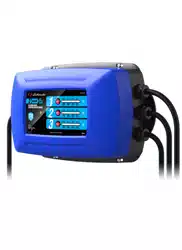Loading ...
Loading ...
Loading ...

• 6 •
3. PREPARING TO CHARGE
3.1 If necessary to remove battery from
vehicle to charge, always remove
grounded terminal from battery rst. Make
sure all accessories in the vehicle are off,
so as not to cause an arc.
3.2 Be sure area around battery is well
ventilated while battery is being charged.
3.3 Clean battery terminals. Be careful to
keep corrosion from coming in contact
with eyes.
3.4 Add distilled water in each cell until
battery acid reaches level specied by
battery manufacturer. Do not overll. For a
battery without removable cell caps, such
as valve regulated lead acid batteries,
carefully follow manufacturer’s recharging
instructions.
3.5 Study all battery manufacturer’s
specic precautions while charging and
recommended rates of charge.
3.6 Determine voltage of battery by referring to
the battery manufacturer’s specications
and make sure that output voltage selector
switch is set at correct voltage.
4. CHARGER LOCATION
4.1 Locate charger as far away from battery
as DC cables permit.
4.2 Never place charger directly above
battery being charged; gases from battery
will corrode and damage charger.
4.3 Never allow battery acid to drip on
charger when reading electrolyte specic
gravity or lling battery.
4.4 Do not operate charger in a closed-in
area or restrict ventilation in any way.
4.5 Do not set a battery on top of charger.
5. GROUNDING AND AC POWER CORD CONNECTIONS
5.1 This battery charger is for use on a
nominal 120 volt circuit. The plug must
be plugged into an outlet that is properly
installed and grounded in accordance with
all local codes and ordinances. The plug
pins must t the receptacle (outlet). Do
not use with an ungrounded system.
5.2 DANGER: Never alter the AC cord or
plug provided – if it does not t the outlet,
have a proper grounded outlet installed
by a qualied electrician. An improper
connection can result in a risk of an
electric shock or electrocution.
NOTE: Pursuant to Canadian
Regulations, use of an adapter plug
is not allowed in Canada. Use of an
adapter plug in the United States is not
recommended and should not be used.
5.3 USING AN EXTENSION CORD
The use of an extension cord is not
recommended. If you must use an
extension cord, follow these guidelines:
• Pins on plug of extension cord must be
the same number, size, and shape as
those of plug on charger.
• Ensure that the extension cord is
properly wired and in good electrical
condition.
• Wire size must be large enough for
the AC ampere rating of charger, as
specied:
Length of cord (feet) 25 50 100
AWG* size of cord 18 18 16
*AWG-American Wire Gauge
6. ASSEMBLY INSTRUCTIONS
6.1 Remove all cord wraps and uncoil the cables prior to using the battery charger.
7. MOUNTING INSTRUCTIONS
7.1 The charger may be permanently mounted
and connected in three different ways:
• Flat mount (oor)
• Wall mount, horizontal position
• Wall mount, vertical position
7.2 When choosing a location:
• Do not restrict the airow under the charger.
Do not mount the charger next to fuel tanks
or below the waterline of the boat. The
charger is rainproof and is approved for
mounting on the weatherdeck.
• To allow for proper air circulation, a
minimum of four inches of unobstructed
area must be permitted on all sides of
the charger.
• Chose a location such that the six-foot
cables can reach the battery(ies).
7.3 Four mounting holes have been provided
for secure installation. Using the charger
Loading ...
Loading ...
Loading ...
